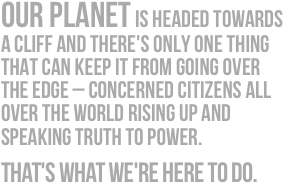-by Moisés Flores Baca
Yesterday I attended a side event about ocean acidification titled “Taking action on Ocean Acidification: Opportunities under UNFCCC” organized by the International Union for the Conservation of Nature. It focused on the ways ocean acidification can be included within international policy against climate change, something that really has to be put on the table since there is no direct mention of ocean acidification in any of the documents under the UNFCCC. The importance of ocean acidification has, nonetheless, been highlighted by some countries such as Chile and Australia that do include the topic on their national plans against climate change.
Ocean acidification is taking place due to the ever higher concentrations of CO2 in the atmosphere. As a first step in the process of ocean acidification surface water absorbs CO2 producing carbonic acid, which is a mild acid, however, through a series of chemical and bio-chemical reactions, this carbonic acid hydrolyzes producing a more acidic compound every time. The lower pH of the ocean as a result of these processes hinders the calcification that allows corals to produce reefs and shelled animals to produce their shells. The saturation of aragonite -which is an essential compound for corals and shelled animals- is decreasing at alarming rates due to acidification, which is predicted to get so bad that in ten year there will be many zones in the ocean where not only there will be low saturation of aragonite, but also, that will be in fact corrosive.
The most vulnerable parts of the ocean to suffer the negative effects of acidification are upwellings, estuaries, polar waters, and tropical and cold water corals which are all important fisheries areas. Further, 10% of the Arctic Ocean is predicted to become corrosive to aragonite in the next decade, this, not only due to higher concentrations of CO2 in the atmosphere, but also because the fresh water entering the ocean as a result of the melting of ice-caps further increases acidity as fresh water has a lower pH than salt water.
Even though there will be certain marine species that will be benefited by the higher acidity of the oceans the overall biological effects will be negative. Part of this negative effect will be felt by food producing organisms, hence harming fisheries around the world, and as a result of this, compromising food security for hundreds of thousands around the world whose main source of protein is the ocean. In short, the negative effects of ocean acidification do not stop at the mere loss of marine biological diversity, it does have a direct effect on our species.
One of the main issues while addressing the problem of ocean acidification is that it requires the reduction of CO2 specifically, as opposed to CO2 equivalent green house gasses (CO2e). Combining the goals of preventing dangerous ocean acidification and preventing climate change thus becomes a problem because even though you might be able to reduce the rate of climate change substantially by reducing emissions of green house gasses that might not translate into a meaningful reduction of ocean acidification since it might be the case that most of those reductions are not of CO2 but of other CO2 equivalent green house gases. The bottom line is that if we solve the problem of ocean acidification we solve the problem of climate change, just as if we save the small island nation states then we save everyone.
There are still some points to refine, for example, which indicator should be used to evaluate the progress of ocean acidification (is pH good enough or do we have to use other indicator such as aragonite saturation?), or what level of emissions is a safe stabilization goal against ocean acidification (450 ppm -parts per million- will not do the job, but do we have to go all the way down to 350 ppm or is there a point in between that will work?) however, it is undeniable that ocean acidification is a problem that has to be higher up on the agenda of the negotiator for COP17. For this to occur, however, it would be useful to make people more aware of the problematic, and this cannot happen if all we talk about is pH or aragonite saturation, measurements that most people would have a hard time relating to. If you tell them the ocean is becoming more acidic they might ask you “does that mean I won’t be able to swim in it anymore?”. We need to find a message that is more digestible by the general public.


